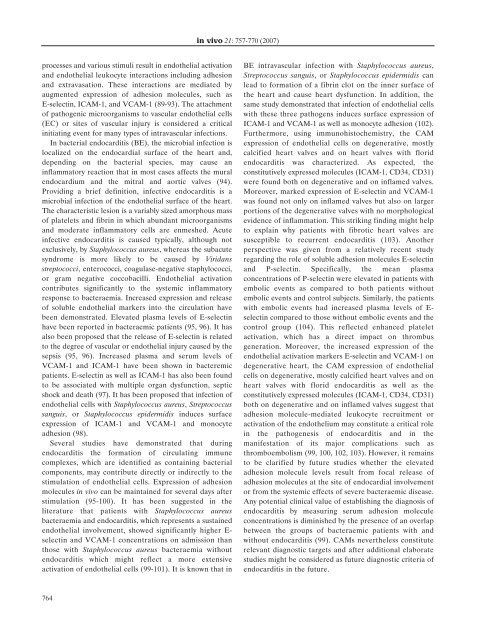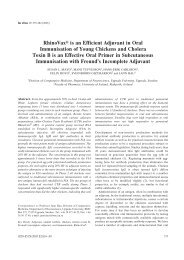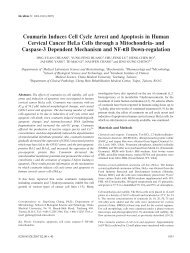Leukocyte and Endothelial Cell Adhesion Molecules in Inflammation ...
Leukocyte and Endothelial Cell Adhesion Molecules in Inflammation ...
Leukocyte and Endothelial Cell Adhesion Molecules in Inflammation ...
You also want an ePaper? Increase the reach of your titles
YUMPU automatically turns print PDFs into web optimized ePapers that Google loves.
processes <strong>and</strong> various stimuli result <strong>in</strong> endothelial activation<br />
<strong>and</strong> endothelial leukocyte <strong>in</strong>teractions <strong>in</strong>clud<strong>in</strong>g adhesion<br />
<strong>and</strong> extravasation. These <strong>in</strong>teractions are mediated by<br />
augmented expression of adhesion molecules, such as<br />
E-select<strong>in</strong>, ICAM-1, <strong>and</strong> VCAM-1 (89-93). The attachment<br />
of pathogenic microorganisms to vascular endothelial cells<br />
(EC) or sites of vascular <strong>in</strong>jury is considered a critical<br />
<strong>in</strong>itiat<strong>in</strong>g event for many types of <strong>in</strong>travascular <strong>in</strong>fections.<br />
In bacterial endocarditis (BE), the microbial <strong>in</strong>fection is<br />
localized on the endocardial surface of the heart <strong>and</strong>,<br />
depend<strong>in</strong>g on the bacterial species, may cause an<br />
<strong>in</strong>flammatory reaction that <strong>in</strong> most cases affects the mural<br />
endocardium <strong>and</strong> the mitral <strong>and</strong> aortic valves (94).<br />
Provid<strong>in</strong>g a brief def<strong>in</strong>ition, <strong>in</strong>fective endocarditis is a<br />
microbial <strong>in</strong>fection of the endothelial surface of the heart.<br />
The characteristic lesion is a variably sized amorphous mass<br />
of platelets <strong>and</strong> fibr<strong>in</strong> <strong>in</strong> which abundant microorganisms<br />
<strong>and</strong> moderate <strong>in</strong>flammatory cells are enmeshed. Acute<br />
<strong>in</strong>fective endocarditis is caused typically, although not<br />
exclusively, by Staphylococcus aureus, whereas the subacute<br />
syndrome is more likely to be caused by Viridans<br />
streptococci, enterococci, coagulase-negative staphylococci,<br />
or gram negative coccobacilli. <strong>Endothelial</strong> activation<br />
contributes significantly to the systemic <strong>in</strong>flammatory<br />
response to bacteraemia. Increased expression <strong>and</strong> release<br />
of soluble endothelial markers <strong>in</strong>to the circulation have<br />
been demonstrated. Elevated plasma levels of E-select<strong>in</strong><br />
have been reported <strong>in</strong> bacteraemic patients (95, 96). It has<br />
also been proposed that the release of E-select<strong>in</strong> is related<br />
to the degree of vascular or endothelial <strong>in</strong>jury caused by the<br />
sepsis (95, 96). Increased plasma <strong>and</strong> serum levels of<br />
VCAM-1 <strong>and</strong> ICAM-1 have been shown <strong>in</strong> bacteremic<br />
patients. E-select<strong>in</strong> as well as ICAM-1 has also been found<br />
to be associated with multiple organ dysfunction, septic<br />
shock <strong>and</strong> death (97). It has been proposed that <strong>in</strong>fection of<br />
endothelial cells with Staphylococcus aureus, Streptococcus<br />
sanguis, or Staphylococcus epidermidis <strong>in</strong>duces surface<br />
expression of ICAM-1 <strong>and</strong> VCAM-1 <strong>and</strong> monocyte<br />
adhesion (98).<br />
Several studies have demonstrated that dur<strong>in</strong>g<br />
endocarditis the formation of circulat<strong>in</strong>g immune<br />
complexes, which are identified as conta<strong>in</strong><strong>in</strong>g bacterial<br />
components, may contribute directly or <strong>in</strong>directly to the<br />
stimulation of endothelial cells. Expression of adhesion<br />
molecules <strong>in</strong> vivo can be ma<strong>in</strong>ta<strong>in</strong>ed for several days after<br />
stimulation (95-100). It has been suggested <strong>in</strong> the<br />
literature that patients with Staphylococcus aureus<br />
bacteraemia <strong>and</strong> endocarditis, which represents a susta<strong>in</strong>ed<br />
endothelial <strong>in</strong>volvement, showed significantly higher Eselect<strong>in</strong><br />
<strong>and</strong> VCAM-1 concentrations on admission than<br />
those with Staphylococcus aureus bacteraemia without<br />
endocarditis which might reflect a more extensive<br />
activation of endothelial cells (99-101). It is known that <strong>in</strong><br />
764<br />
<strong>in</strong> vivo 21: 757-770 (2007)<br />
BE <strong>in</strong>travascular <strong>in</strong>fection with Staphylococcus aureus,<br />
Streptococcus sanguis, or Staphylococcus epidermidis can<br />
lead to formation of a fibr<strong>in</strong> clot on the <strong>in</strong>ner surface of<br />
the heart <strong>and</strong> cause heart dysfunction. In addition, the<br />
same study demonstrated that <strong>in</strong>fection of endothelial cells<br />
with these three pathogens <strong>in</strong>duces surface expression of<br />
ICAM-1 <strong>and</strong> VCAM-1 as well as monocyte adhesion (102).<br />
Furthermore, us<strong>in</strong>g immunohistochemistry, the CAM<br />
expression of endothelial cells on degenerative, mostly<br />
calcified heart valves <strong>and</strong> on heart valves with florid<br />
endocarditis was characterized. As expected, the<br />
constitutively expressed molecules (ICAM-1, CD34, CD31)<br />
were found both on degenerative <strong>and</strong> on <strong>in</strong>flamed valves.<br />
Moreover, marked expression of E-select<strong>in</strong> <strong>and</strong> VCAM-1<br />
was found not only on <strong>in</strong>flamed valves but also on larger<br />
portions of the degenerative valves with no morphological<br />
evidence of <strong>in</strong>flammation. This strik<strong>in</strong>g f<strong>in</strong>d<strong>in</strong>g might help<br />
to expla<strong>in</strong> why patients with fibrotic heart valves are<br />
susceptible to recurrent endocarditis (103). Another<br />
perspective was given from a relatively recent study<br />
regard<strong>in</strong>g the role of soluble adhesion molecules E-select<strong>in</strong><br />
<strong>and</strong> P-select<strong>in</strong>. Specifically, the mean plasma<br />
concentrations of P-select<strong>in</strong> were elevated <strong>in</strong> patients with<br />
embolic events as compared to both patients without<br />
embolic events <strong>and</strong> control subjects. Similarly, the patients<br />
with embolic events had <strong>in</strong>creased plasma levels of Eselect<strong>in</strong><br />
compared to those without embolic events <strong>and</strong> the<br />
control group (104). This reflected enhanced platelet<br />
activation, which has a direct impact on thrombus<br />
generation. Moreover, the <strong>in</strong>creased expression of the<br />
endothelial activation markers E-select<strong>in</strong> <strong>and</strong> VCAM-1 on<br />
degenerative heart, the CAM expression of endothelial<br />
cells on degenerative, mostly calcified heart valves <strong>and</strong> on<br />
heart valves with florid endocarditis as well as the<br />
constitutively expressed molecules (ICAM-1, CD34, CD31)<br />
both on degenerative <strong>and</strong> on <strong>in</strong>flamed valves suggest that<br />
adhesion molecule-mediated leukocyte recruitment or<br />
activation of the endothelium may constitute a critical role<br />
<strong>in</strong> the pathogenesis of endocarditis <strong>and</strong> <strong>in</strong> the<br />
manifestation of its major complications such as<br />
thromboembolism (99, 100, 102, 103). However, it rema<strong>in</strong>s<br />
to be clarified by future studies whether the elevated<br />
adhesion molecule levels result from focal release of<br />
adhesion molecules at the site of endocardial <strong>in</strong>volvement<br />
or from the systemic effects of severe bacteraemic disease.<br />
Any potential cl<strong>in</strong>ical value of establish<strong>in</strong>g the diagnosis of<br />
endocarditis by measur<strong>in</strong>g serum adhesion molecule<br />
concentrations is dim<strong>in</strong>ished by the presence of an overlap<br />
between the groups of bacteraemic patients with <strong>and</strong><br />
without endocarditis (99). CAMs nevertheless constitute<br />
relevant diagnostic targets <strong>and</strong> after additional elaborate<br />
studies might be considered as future diagnostic criteria of<br />
endocarditis <strong>in</strong> the future.






